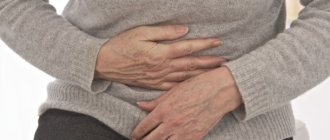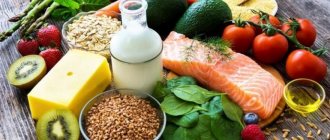Constipation in adults is a common problem, one of the reasons for which is a violation of nutritional principles. Doctors prescribe medications, but if eating habits remain unchanged, symptoms will recur, even if they are eliminated in a timely manner. Proper selection of products minimizes the number of medications. If constipation is caused by eating junk food, then healing from the disease by normalizing digestion is better than drug therapy, since the body independently finds ways to function optimally, eliminating the disease with its own resources. Diet is a method of getting rid of gastrointestinal problems at the stage of their occurrence. In the process of following the recommendations for drawing up a treatment menu, you will need culinary skills, but some recipes are so simple that anyone can master them.
- 6 Good habits should be tasty. New, original recipes will help diversify the menu.
- 7 Cooking recipes
- 8 Diet results: treatment effectiveness
- 9 Other diets for adults
- 10 Prevention
What is constipation and what can it be like?
Constipation is a sensitive topic and many people are hesitant to talk about it even with a doctor. However, the study of processes in the body should take place without shame and embarrassment. Constipation is a retention of stool for several days, difficulty defecating. Other names for this pathological process are constipation, obstipation.
Ideally, there should be stool every day; a delay in defecation for 48 hours, provided there are no difficulties in the process, is not a deviation. If the urge to empty the intestines is not observed within 3 days, then this is a sign of constipation.
Constipation can be a consequence of illness, a side effect of taking medications, pregnancy, or the result of an unbalanced diet. Symptoms of constipation:
- slow transit of feces through the large intestine;
- difficult evacuation of feces.
Constipation is a disorder of the intestines, which is manifested by difficulty and delayed bowel movements.
Depending on the severity of one of the symptoms, cologenic and proctogenic constipation are distinguished. If the patient feels the rectum is full of feces, but bowel movements do not occur, then this is proctogenic constipation. Its causes are not only problems with digestion, but also a decrease in the sensitivity of nerve endings in the tissues of the rectum.
Chronic constipation is characterized by a stop in the movement of feces through the large intestine. In this case, cleansing the intestines is necessary to avoid intoxication of the body.
With self-diagnosis, there is a high probability of error; only a doctor will help to correctly determine the type of constipation and determine its causes, and choose the right drug. It is not always possible to get rid of a problem with diet alone.
The optimal therapeutic effect can be obtained by combining drug therapy and correction of eating habits.
Causes
The most common factors causing constipation and bloating are:
- Lack of rationality in nutrition. The menu of a modern person is dominated by quickly digestible carbohydrates (granulated sugar, rolls, white bread, animal protein), the consumption of which leads to constipation. Insufficient intake of fluids, plant fibers, and coarse fiber also leads to intestinal obstruction.
- Taking medications. If a person is undergoing treatment, then you should pay attention to the instructions for the medications you are taking. The column “Adverse reactions” may indicate the occurrence of constipation. Antispasmodics, analgesics, NSAIDs, antibiotics, antidepressants, etc. lead to such a reaction in the body.
- Psychological condition. In the modern frantic pace of life, almost every person periodically experiences mental stress, uncontrollable fear, depression, and a depressed state. There is often a disruption in rest and work patterns. As a result of psychological discomfort, daily bowel movements become difficult.
- Habits and lifestyle. A person is able to control the desire to perform the process of defecation. In other words, endure it. So, if there is a systematic morning rush to work, a day overloaded with events, excitement before important meetings, sometimes there is simply no time left to go to the toilet. And the habit of suppressing the urge to empty the intestines is formed. Which further leads to constipation.
- Diseases. In addition to external factors that can influence the systematicity of bowel movements, a number of internal problems that occur in the body and provoke constipation can be identified:
- anal fissures, hemorrhoids;
- weak muscle tone of the pelvic floor;
- inflammatory processes in the intestines;
- diseases of the thyroid gland, adrenal glands;
- abnormal development of the colon, polyps, tumors;
- poisoning of the body with metals (lead, mercury, etc.);
- vascular diseases that disrupt blood flow in the intestinal vessels;
- neurological disorders (multiple sclerosis, spinal cord injury, etc.).
Diet for constipation: do's and don'ts
Nutrition for constipation should help improve digestion due to its complex effect on the organs of the gastrointestinal tract. Main goals of the diet:
- restoration of intestinal motility, normalization of its work;
- cleansing the body;
- reduction of gas formation;
- relieving irritation of the gastric mucosa.
You should have stuck to the diet even before the first symptoms appeared, but learning from your mistakes allows you to understand the individual reactions of the body. If constipation was preceded by the consumption of certain foods, they should be calculated and excluded. And start following a diet at the first sign of intestinal problems.
Principles of nutrition for constipation:
- Drink 1.5–2 liters of fluid per day. Facilitates the evacuation of waste and toxins from the body.
- Eat small meals 5-6 times a day to unload the stomach.
- Include fiber-rich foods in your diet. This is an essential nutritional component that helps cleanse the intestinal walls.
- Consume vegetables and fruits both raw and processed. They cleanse the intestines and facilitate the removal of feces.
- Eliminate sticky porridges that have a pasty consistency, such as rice and semolina, from your diet. This has a bad effect on the composition of feces.
- Avoid any jelly-like products: jelly, jellied meat.
- Avoid fried foods, as there is a risk of triggering a fermentation reaction in the intestines. It is necessary to replace them with stewed ones.
- Eat warm food rather than hot food.
These nutritional principles are universal for everyone and are equally useful for the elderly, pregnant women and people suffering from other diseases of the gastrointestinal tract.
To avoid fecal stagnation, laxatives may be included in therapy. Eating after taking medication has its own characteristics. On the first day after the intestinal cleansing procedure, you should limit yourself to eating vegetables and fruits, whole grain cereals, and fermented milk products.
Diet functions, how to eat for chronic constipation
Proper nutrition for constipation provides:
- decreased acidity of gastric juice;
- choleretic effect;
- normalization of intestinal microflora;
- laxative effect.
The combination of treatment and proper nutrition will inevitably give a quick therapeutic effect within a week. If you are prone to chronic constipation, your diet should become part of your lifestyle. Fortunately, he is not that strict.
If you are prone to chronic constipation, diet should become part of your lifestyle.
Proper nutrition regimen for women and men
If serious health problems have been ruled out, but systematic constipation has not gone away, you should pay attention to your diet, make it correct and consistent.
For women and men, this diet is no different and is assessed by 4 criteria:
- Balance. The correct ratio of proteins, carbohydrates and fats will provide the body with everything it needs and prevent constipation.
- Regularity. To accustom the body to stable functioning, you need to eat at the same time, in small portions and often (4-5 times a day). Discipline in nutrition will prevent not only constipation, but also overeating.
- Enriched composition. Food must contain a sufficient amount of minerals and trace elements. For example, potassium deficiency can lead to innervation of intestinal tissues, which contributes to poor bowel movements in the body.
- Cooking method. Preference should be given to steamed, boiled or baked products. Eating spices, fried or spicy foods will irritate the intestinal walls and aggravate the situation with fecal stagnation.
What products are allowed - table
| Category | Scroll | Impact on the body |
| Vegetables |
| cellulose content provides acceleration of the motor function of the large intestine |
| pumpkin |
| |
cabbage:
| beneficial properties of fiber promote intestinal motility | |
| Cereals |
|
|
| bran | beta-glucan content helps lower cholesterol and cleanse blood vessels | |
| Nuts and seeds |
| promote contractions of the gallbladder, increase the amount of bile |
| sunflower seeds |
| |
| Dairy products |
|
|
| Dried fruits |
|
|
| Fruits |
|
|
| Berries |
| |
| Meat | Easily digestible varieties:
| foods that are gut-neutral and rich in nutrients |
| Fish | Low-fat varieties:
|
Portion volume and food processing methods
To improve your health, it is recommended to consume 30 grams of fiber; for this you need to eat 200 grams of vegetables and fruits per day. Tasty and healthy menu items: freshly squeezed juice, dried fruit compote, berry jam. A good breakfast dish: a mixture of dried fruits and nuts with cottage cheese and honey.
Pumpkin in any form helps cleanse blood vessels.
Use pumpkin, or better yet, its freshly squeezed juice. If this is not possible, just cook any pumpkin dishes. Alexander Korodetsky “Natural cleansing of blood vessels and blood according to Malakhov”
Cabbage consumption should be limited to avoid increased gas production, which can make digestion difficult. A serving of soup per day with the addition of broccoli, white cabbage or cauliflower is the daily norm. Sauerkraut is an excellent remedy for normalizing digestion; pregnant women at the stage of toxicosis are well familiar with its beneficial effects; this product is absorbed perfectly.
Wheat bran can be bought at the pharmacy; to prepare it, you need to dilute it in a bowl with boiling water; in addition, bran is contained in bread. Nuts are consumed in the amount of 30 g per day. Meat and fish are cooked boiled or stewed; frying is prohibited.
- Eating 1 glass of seeds in the evening ensures bowel movements in the morning.
- A good remedy for constipation is a glass of warm water with lemon juice dissolved in it.
- Before eating, it is useful to drink 1 spoon of vegetable oil.
Liver restoration: what foods contribute to this
When choosing foods for your diet, you should focus not only on the benefits for the intestines, but also on improving liver function, the proper functioning of which contributes to the systemic interaction of the gastrointestinal tract. The choleretic effect occurs as a result of consuming foods such as:
- honey;
- sunflower oil;
- olive oil;
- artichokes.
Table with a list of natural fast-acting laxative products
Products with a laxative effect have the following qualities:
- liquefy feces;
- improve peristalsis;
- stimulate the production of secretions in the intestinal glands;
- promote the movement of feces, making them more slippery.
| Product group | Products | Properties |
| Cereals | Buckwheat, barley, oats, wheat | Cereals should be whole grain or coarsely ground. |
| Vegetables | Beets, carrots, cabbage, cucumbers, onions, pumpkin | Thanks to the fibrous structure, they perfectly form the mass and help push it through. |
| Fruits | Plums, pears, bananas, apples | Thanks to the fiber and sugars in the composition, they have a positive effect on peristalsis. Fiber forms mass, sugar attracts water into the intestines. |
| Porridge | Oatmeal, pearl barley, buckwheat, millet | Porridge should be cooked in water, add vegetable oil. They also perfectly form feces and stimulate its passage. |
| Vegetable oils | Sunflower, olive, flaxseed, camelina | Act as a lubricant for the colon and help enhance gliding. Consuming oils on a regular basis prevents constipation. |
| Dairy products | Kefir, yogurt, kumiss, yogurt | The bacteria contained in these products help the fermentation process in the intestines and stimulate the process of bowel movements. |
Prohibited foods that can cause constipation - table
| List of products | Effect on the body |
| thickening the consistency of feces, which can contribute to their further consolidation in the colon and lead to the formation of fecal stones |
| danger of heartburn |
| bloating |
| fixing action |
|
|
| some vegetables have fixing properties due to their starch content, others cause fermentation in the stomach |
| boiled carrots | consolidates |
| tannins act on the intestinal mucosa, slowing down its peristalsis |
Neutral products: are milk and eggs healthy?
The reasons for limiting foods are related to their negative effects on digestion and strengthening properties.
By studying the menu, you can be convinced that despite the restrictions in the choice of foods, food for constipation can be tasty
There are neutral products, for example, milk, which are not beneficial, they are not prohibited, but can be replaced with more effective ones for digestion.
Scrambled and hard-boiled eggs are prohibited for constipation; it is recommended to cook an omelet or boil a soft-boiled egg.
Diet for flatulence with constipation
If constipation is combined with gas formation, it is necessary to make some adjustments to the diet.
First, you need to limit your consumption of foods that cause flatulence:
- Most types of legumes: peas, chickpeas, beans, lentils, beans, soybeans.
- Fresh white and flower cabbage (if consumed, then only baked or stewed).
- Some types of fermented milk products: milk, cheeses, kefir.
- Fresh fruits – apples, pears, peaches, apricots.
- Seeds.
- Eggplant.
- Flour products (especially white flour).
- Combinations of dairy products with sour fruits, cereal porridges with milk, fresh bread with kefir.
Secondly, drink herbal teas that help relieve bloating: mint, chamomile and St. John's wort. In addition, you need to maintain a high level of beneficial bacteria in the stomach and colon, because bloating often occurs due to pathogenic microflora.
Sample menu for the week: recommended dishes for a sick person
Monday
Breakfast
- oatmeal with pieces of dried fruit;
- a glass of freshly squeezed juice.
Dinner
- steamed minced meat cutlets;
- green vegetable salad;
- bread.
Afternoon snack
- fruits;
- rosehip decoction.
Dinner
- kefir;
- pearl barley porridge.
Tuesday
Breakfast
- buckwheat porridge;
- drinking yogurt.
Dinner
- borsch;
- boiled chicken;
- green salad.
Afternoon snack
- Mint tea;
- bran bread;
- honey.
Dinner
- kefir;
- fruits.
Wednesday
Breakfast
- cereals
- with honey and dried fruits;
- kefir.
Dinner
- fish soup;
- pumpkin puree.
Afternoon snack
- diet bread
- with berry jam;
- compote.
Dinner
- seeds;
- drinking yogurt.
Thursday
Breakfast
- muesli;
- freshly squeezed orange
- juice.
Dinner
- sauerkraut;
- minced meat cutlets;
- tomato sauce.
Afternoon snack
- carrot salad with prunes;
- bread with bran.
Dinner
- fruits;
- kefir;
- nuts.
Friday
Breakfast
- drinking yoghurt;
- fruit salad.
Dinner
- pearl barley porridge;
- chicken breast.
Afternoon snack
- beet salad;
- compote.
Dinner
- Ryazhenka with breadcrumbs.
Saturday
Breakfast
- muesli with cottage cheese and honey.
Dinner
- pumpkin puree soup;
- buckwheat with vegetable cutlet.
Afternoon snack
- fresh juice;
- bread with butter.
Dinner
- fruit salad with sour cream.
Sunday
Breakfast
- oatmeal with sour cream.
Dinner
- tomato puree soup;
- spinach;
- meat cutlet.
Afternoon snack
- compote with dried fruits.
Dinner
- low-fat cottage cheese with pieces of fruit.
Review of products with laxative effects
Natural products have a laxative effect, cleanse the intestines of waste and toxins, and strengthen it. This is a folk method of fighting the disease. Loosening the intestines with food is more effective and healthier than using medications with a similar effect. Products for constipation:
Fruits:
- Bananas, thanks to potassium and fiber, restore the functioning of the stomach and stimulate emptying in case of constipation.
- Apples normalize the functioning of the gastrointestinal tract.
- Melon is useful when taken on an empty stomach, but as an addition after a hearty lunch it can fix the problem.
- Raw pear helps relieve constipation as it is rich in amino acids and minerals.
- Mango is a digestive system regulator and has a mild laxative effect. Eliminates bloating and flatulence.
- Citrus. Lemon, orange and grapefruit juice stimulates the production of gastric juice and the release of the gallbladder.
- Feijoa. The fruit pulp contains pectin, which provides a laxative effect.
Raw vegetables suitable for the menu:
- Beetroot - helps improve digestion in adults and children. Removes toxins from the body. Positively affects the functioning of the cardiovascular system.
- Tomatoes are rich in vitamins and antioxidants and are used as a natural preventative against the formation of malignant tumors in the large intestine. When eaten fresh, they stimulate peristalsis and liquefy feces. Pickled (pickled) tomatoes are used as a laxative.
- Cabbage (white cabbage or broccoli) relaxes and cleanses the intestines.
- Carrots help normalize digestion, rid the body of toxins, and cleanse the circulatory system.
Seeds, nuts, and foods high in fiber and amino acids will help you empty your intestines:
- peas, legumes;
- onion;
- prunes;
- cucumber pickle;
- olive, sunflower oil;
- zucchini;
- bran;
- kefir.
Diet results: treatment effectiveness
As a result of strictly following the diet, the following changes in well-being will occur:
- stool will become regular;
- digestion will speed up;
- bloating, heartburn, flatulence will disappear;
- a feeling of comfort will be established in the stomach.
Activation of digestive processes by changing the composition of daily consumed dishes improves metabolism in general. People with a fast metabolism are practically not susceptible to constipation; the high speed of reactions during the digestion of food contributes to the establishment of regular bowel movements.
Organizing a lunch break at work: in order not to disrupt your diet by snacking in cafes and canteens in the middle of the working day, you can prepare a container of food in the evening.
As your recovery progresses, you can gradually introduce some prohibited foods into your diet. However, they should be consumed in limited quantities to improve the taste of dishes. Now this will not cause unpleasant symptoms, because one of the effects of proper nutrition is to increase the digestibility of foods.
Ketogenic diet for constipation
Ketogenic diets are used by athletes to increase endurance during exercise. Diet is also used as a means to accelerate fat burning. This diet is based on a low-carbohydrate diet. It starts the process of breaking down subcutaneous lipids within a few days. This method of losing weight is especially common among women.
The keto diet is based on reducing your daily carbohydrate intake to 80-90g per day. However, when switching to a low-carbohydrate diet, there is a risk of encountering impaired peristalsis.
Therefore, when following a keto diet, there are a number of recommendations to avoid problems with regular bowel movements:
Eating foods high in sodium and potassium . A large amount of sodium is found in seaweed, celery, and corn. Dried apricots, bran, pistachios, dried porcini mushrooms, watercress, and parsley are rich in potassium. Including foods rich in these elements in your diet will help prevent constipation and dehydration.
Saturation of the body with magnesium . This element has a mild laxative effect and calms the nervous system (stress is one of the factors that provokes constipation). Rich in magnesium: sesame seeds, wheat bran, cashew nuts, buckwheat, bananas, basil. In addition, the element is high in seaweed and dried porcini mushrooms. Of the dried fruits, the most magnesium is found in dried apricots, prunes, figs, dates, and raisins. This way, the side effects of the ketogenic diet can be avoided.
Other diets for adults
If you have constipation, you should forget about the protein diet that is used by athletes. This diet should be completely excluded due to the abundance of meat, cottage cheese and eggs, which are prohibited for constipation.
Table No. 3: proper nutrition according to Pevzner
A doctor may recommend diet table No. 3, another name is the Pevzner therapeutic diet. She excludes from the menu all foods that trigger the processes of fermentation and putrefaction in the intestines. For example, spicy, fatty, alcohol, canned food, smoked meats.
List of recommended diet products according to Pevzner:
- all vegetables except radishes and radishes;
- legumes;
- pasta;
- vegetable and butter;
- egg;
- milk only when added to a dish;
- salmon caviar;
- aspic, jellied meat;
- ham;
- all fruits, pear recommended.
The sweets indicated in the diet (marmalade, jelly, marshmallows, marshmallows, jam, caramel) do not harm digestion, but it makes sense to introduce these confectionery products only at the recovery stage.
Chronic spastic colitis of the intestine with flatulence
Not all products allowed for a healthy person are suitable for a person suffering from spastic colitis. If you follow dietary recommendations, you can prevent constipation. A diet for chronic intestinal colitis with flatulence and constipation involves consuming the following dishes and healthy foods:
- honey;
- celery;
- dried fruits;
- leaf salad;
- apples without peel;
- wholemeal bread;
- lean meat and fish;
- greens (parsley, dill);
- baked beets or pumpkin;
- fruit and berry compotes;
- sunflower and butter;
- buckwheat, millet, pearl barley porridge;
- cucumbers, tomatoes, raw carrots;
- stew of carrots, zucchini and cauliflower;
- cream soup with vegetable, second beef or chicken broth;
- fermented milk drinks (ryazhenka, kefir, yogurt, sourdough).
Prevention
The best treatment for a disease is its prevention. For preventive purposes, vegetables, fruits, bran bread, and fermented milk products should be included in the menu.
To minimize the likelihood of constipation, completely avoid fried foods, fast food, hot spices, fatty meats and fish, and drink coffee in moderation (no more than 1 cup per day). Avoid visiting some food establishments.
Stable benefits for the functioning of the gastrointestinal tract will come from introducing just a few products into the daily diet: oatmeal in the morning, vegetable salad for dinner, a glass of kefir before bed.
New eating habits are acquired within 3 weeks; after this period, the body undergoes a restructuring and a natural desire arises to eat what is beneficial.
Constipation or constipation should not scare you, because discipline is the most important thing in getting rid of this pathology. Properly organized nutrition in combination with medications will restore the condition of the stomach in 1–2 weeks.
Having become acquainted with a therapeutic diet, you can get rid of problems with the gastrointestinal tract and cure constipation. The therapy process will require mastering new recipes; some may find it difficult to give up familiar foods, so the most effective menu for recovery includes tasty and healthy dishes. With consistent adherence to the diet, digestion becomes fast, stools become regular, and the stomach feels comfortable. It is important to remember that poor nutrition can only be one of the causes of constipation; to eliminate the others, treatment prescribed by a doctor will be required.
Recipes
The dishes that will be presented below will not only help normalize the evacuation function of the large intestine, but will also have a beneficial effect on the general condition of the human body. Changes can be made to the mentioned recipes based on individual culinary preferences.
Cabbage cutlets
Cutlets made from cabbage and oatmeal can be served with one of the side dishes, and can also be used as a snack between lunch and afternoon tea. Before preparing cabbage cutlets, it is recommended to stock up on the following ingredients:
- 400 g white cabbage.
- 3 tablespoons Hercules flakes.
- 2 chicken eggs.
- 30 g butter.
- 1/2 cup whole milk.
- Salt to taste.
Preparation:
- White cabbage must be finely chopped, then simmered in a dry frying pan for 10 minutes, adding a small amount of water.
- Next, add milk and Hercules flakes to the pan, after which everything is evenly mixed and kept for 10 minutes over low heat.
- Remove the finished mixture from the heat and allow to cool, after which chicken eggs and salt to taste are added to it.
- The prepared cabbage mixture is filled into silicone molds for baking muffins and placed in the oven for half an hour at a temperature of 180 degrees.
Pumpkin porridge
To make pumpkin porridge you will need the following components:
- 1/2 cup millet.
- 1 small pumpkin.
- A small handful of raisins.
- 25 g butter.
- 350 ml milk.
- Sugar or salt to taste.
How to cook:
- You need to cut off the top of the pumpkin, then peel the vegetable from the seeds and core.
- Milk is poured into the resulting cavity, millet is added, butter is added, as well as salt or sugar to taste.
- All the ingredients inside the pumpkin are thoroughly mixed and the vegetable is covered with the previously cut top.
- The finished pumpkin is placed in an enamel bowl, which is filled with water so that the liquid covers the vegetable from below by 1 cm.
- Place the container with water and pumpkin in the oven for 1 hour at a temperature of 170-180 degrees.
Vegetable salad
In order to get a light and healthy dish you need to take:
- 200 g white cabbage,
- celery greens,
- 1 carrot,
- 1 red beet.
Cooking instructions:
- White cabbage must be finely chopped and mixed with finely chopped celery.
- Next, use a medium grater to chop the carrots and beets, then add the ingredients to the cabbage and celery.
- The peculiarity of the salad is that no vegetable oil or salt is used in its preparation.
- This dish effectively activates the motor mechanisms of the intestinal wall and promotes the natural elimination of digested food.
Meat casserole
To prepare a hearty meat casserole, you need to take the following ingredients:
- 2 chicken egg whites.
- 75 ml whole milk.
- 350 g minced chicken breast or beef.
- A small pinch of salt.
Let's prepare it like this:
- Add milk, table salt and chicken proteins to the minced meat, then mix evenly.
- Cutlets are formed from the prepared minced meat and placed on a baking sheet pre-greased with one of the types of oil.
- This dish can be baked in the oven for a quarter of an hour at a temperature of 180 degrees or steamed.
Share on social media networks:
Rate the material:
No ratings
Ilona Ganshina
13.11.2018
4495
0
Found a mistake? Select it and press Ctrl+Enter
Report a bug
Similar materials
Diet for gastritis of the stomach. List of products, menu, recipes
Eastern diet: description, rules, menu
Dr. Dukan's diet. Description, recommendations, menu
Diet for gout. Menu for the week. Products, recipes
Therapeutic diet. Table No. 7 according to Pevzner. Menu for the week
Diet No. 3
Despite the fact that a single diet for constipation has not been invented, diet No. 3 is often used for such patients, since it is believed that it is best suited in this case. The proportions of proteins, fats and carbohydrates in this diet are 1:1:4. In this case, the amount of protein per day should be approximately 100 g. Half should be vegetable protein.
Of 100 g of fat, most should be represented by animal ingredients. And only 30% is allocated to vegetable fats. The amount of carbohydrates consumed in this case is 400 g. You can consume 15 g of salt per day, and at least 1.5 liters of liquid. The energy value per day is approximately 3000 kcal.
Menu for constipation in adults for a week
At home, you can get rid of the disease by following the following diet:
| Menu for adults for constipation | ||||
| Day of the week | Breakfast | Snack | Dinner | Dinner |
| Monday | Cereal porridge with water, fermented milk drink | Fresh fruit or dried fruit | Fish soup, laxative vegetable, bran bread | Stewed vegetables with white meat, compote |
| Tuesday | Vitamin salad, nuts, juice | Low-fat cottage cheese, sour cream, green tea or chicory | Vegetable broth, baked poultry with buckwheat | Vegetable stew, kefir |
| Wednesday | Oatmeal with dried fruits, freshly squeezed juice | Meatless borscht, barley with stewed chicken, carrots | Steamed vegetables with fish cutlet, herbal tea or compote | Bran, yogurt |
| Thursday | Buckwheat, fruit, green tea | Cottage cheese with dried fruits or nuts | Diet soup, cabbage rolls | Salad (carrots, cabbage), compote |
| Friday | Oatmeal with dried fruits, yogurt | Fresh fruits | Fish soup, baked potatoes with vegetables, juice | Beetroot and carrot salad with sour cream, compote |
| Saturday | Bran softened in curdled milk or yogurt | Vitamin salad, carrot nectar | Chicken soup, baked fish, cereal, tea | Dried fruits, kefir |
| Sunday | Cottage cheese or casserole, chicory | The vinaigrette | Soup without meat, buckwheat with chicken cutlets | Drying, yogurt or kefir |
Products that strengthen stool and recipes for constipation
There are foods that increase the likelihood of developing hard stools. However, this does not mean that you need to stop eating foods that cause illness completely. They should be removed while the gastrointestinal tract normalizes, and then gradually introduced into the diet in moderate dosage. What not to eat if you are constipated:
- dairy products (not to be confused with fermented milk) - whole milk, cream, sour cream;
- refined carbohydrates - white bread, especially freshly baked, pasta, cookies, sweets, cakes, chocolate;
- semi-finished products, frozen food;
- fried and fatty foods;
- green bananas (ripe ones, on the contrary, help solve the problem);
- store-bought sauces (adjika, ketchup, mayonnaise);
- strong broths based on red meat;
- fats of animal origin, namely lard, lamb fat;
- fruits and vegetables with astringent properties - garlic, sorrel, mushrooms, blueberries, sorrel, lingonberries, quince - they all cause fermentation in the intestines.
If the diet includes mainly protein products (meat, fish, dairy products), then the likelihood of intestinal problems increases.
There are laxative products for constipation, the use of which acts as a medicine. Traditional medicine recommends the following recipes for the disease:
- A glass of water on an empty stomach is the simplest remedy for constipation.
- Drinking a glass of kefir at night is especially convenient for preventing constipation in women on a diet.
- Rinse your mouth with olive oil.
- Dried fruit puree - dried apricots, raisins, prunes, figs and dates (they can loosen stools).
- Warm mineral water in the morning on an empty stomach is also an effective way to get rid of constipation.
- Whole grain bread and cereals that you can eat when you are constipated.
- Massage and gymnastics for the abdomen.
Dried fruit puree, especially prunes, is the best food for constipation. A tablespoon of the mixture eaten daily improves immunity and prevents relapses of constipation in adults.
Efficacy of diet Table 3 and 4 for constipation
Diet No. 3 stimulates the motor activity of the gastrointestinal tract and is indicated for chronic intestinal diseases, hemorrhoids, and constipation. The “Table 3” nutrition system is based on the regulation of substances entering the body, their quantity and quality. You need to eat 5-6 times a day. Recipe for recovery - soups, cereals, herbs, vegetables, dietary meat, fruits, drinks. Sweets and flour products are allowed in limited quantities. Dairy products can be added to dishes. Do not use:
- spicy, fatty;
- animal fats;
- legumes;
- eggs;
- vermicelli, rice, semolina.
The “Table 4” diet must be followed after intestinal surgery or during an exacerbation of the disease. Useful in the presence of helminths, dysbacteriosis, colic and increased gas formation. Helps eliminate chronic constipation. Prescribed for stomach diseases (gastritis, ulcers). In case of childhood intestinal disorder, dietary nutrition is prescribed to the nursing mother, and the infant feeds on her milk. You cannot follow a diet during pregnancy. The diet involves reducing the load on the mucous membrane, which reduces fermentation processes. The effect is achieved by reducing the amount of carbohydrates and fats consumed.
The “Table 4” diet provides for compliance with the norm of protein entering the body while limiting carbohydrates and fats. Depending on the disease, the doctor prescribes different types of table. The differences lie in the energy value of the dishes and the ratio of useful elements. Basic rules of “Table 4”:
- Complete refusal of sugar and salt.
- Ban on foods that cause fermentation.
- Drink milk only in its pure form (1 glass per day), without adding it to dishes.
- The serving size is minimal (the size of a fist).
- Only liquid, semi-liquid and pureed food.
What foods cause problems with bowel movements?
Low physical activity, taking antibiotics or certain foods can cause bowel dysfunction. Synthetic additives in food, dyes and empty calories make defecation difficult and can cause various diseases of the gastrointestinal tract. You should not eat fast food or foods low in fiber. Foods that will not be beneficial for intestinal problems:
- fast food;
- meat products (especially in combination with potatoes, pasta);
- bakery;
- rice, semolina, dishes prepared from them;
- chocolate, sweets;
- pasta;
- boiled eggs;
- blueberries, dogwood, lingonberries;
- red wine, red grapes;
- canned goods;
- coffee, cocoa.











